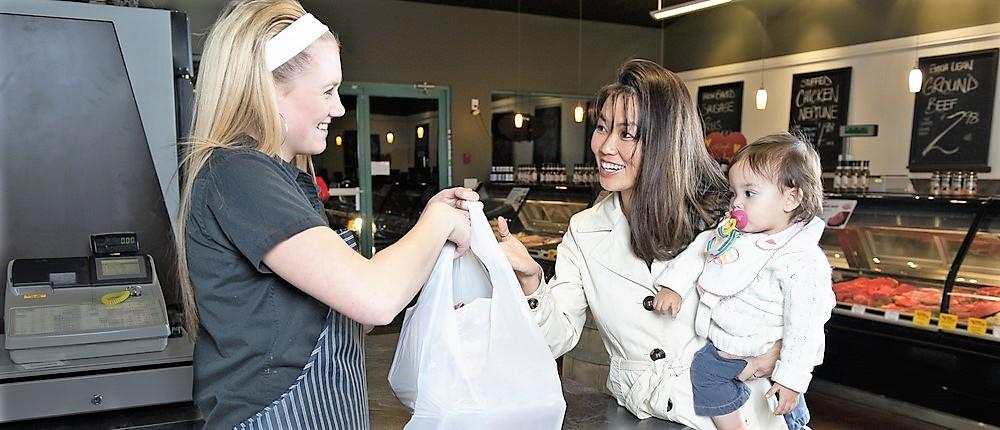Do you ever worry about the demands of the cashier who has to handle every item that you eat in a week? We do. And not just because we’ve been hired to! So do academics, apparently. Researchers from the Universities of Waterloo, Laurentian, and Arizona State recently published a paper in the International Journal of Industrial Ergonomics, summarizing an experiment with grocery clerks. The researchers hooked up the employees to electromyography recorders to get an idea of how hard their shoulder and low back muscles were working. The cashiers worked under a variety of conditions:
- Packing at low, medium, and high heights
- Packing into bins, reusable bags, and plastic bags
- Working at low (6 items per order) and high (20 items per order) intensities
Not all cashier workstations offer height-adjustability, but it appears that, even if they do, cashiers don’t always use this feature. Bag wells, those low spots in the counter, allow the cashier to lower items into the bag instead of lifting them. The researchers wanted to know whether packing height made any difference.
Now that more people are using reusable bags, the cashier’s job has changed a bit. Many workstations are designed to accommodate plastic bags perfectly, but the reusable bags require a bit of fiddling to open and load. When cashiers need to pack items into bags, they often scan a few items and then set them aside, and later pack them. This is what ergonomists call “double-handling”, and it increases the demands on the body needlessly. Double handling is less common when packing into shallower bins. Further bins slide around easier – a bag has to be lifted to be moved toward the customer.
At first glance, checkout work looks pretty steady – is there any opportunity to change the intensity of work? Certainly differences exist between the “express” and regular lanes at the grocery store. Those of us who pause to consider which lane will get us through quicker will likely agree that a small number of full carts usually takes less time to process than several carts with only a few items. In fact, a New York Times reporter found that each item in the order takes about 3 seconds to process, and each money transaction takes about 41 seconds. Therefore, one cart with 80 items would take almost 5 minutes to process, whereas 4 carts with only 12 items each will take over 5 minutes. Given the choice, it’s better to wheel your cart up behind one full cart than 4 almost empty ones. The financial transaction, fortunately for the cashier (if not for the customer) allows a “break” from packing, which the body perceives as muscle recovery.
The researchers found that the highest muscle demands occurred when cashiers worked at high heights, with bags (reusable or plastic), and with more items between breaks. What does that mean for cashiers?
- If you have control over the height of your workstation, adjust it so the bag sits 10-15 cm below elbow height. A little bit of bending is better than a lot of over-shoulder work. Use the bag well, if you have one, and try to avoid double-handling when possible. (Don’t put the laundry detergent on top of the grapes, though!)
- You may not be able to control whether the customer chooses bags or bins, but if your store can encourage people to use bins instead of bags, then bins are better. Bins slide along the surface and don’t have to be lifted. They also don’t have to be held open.
- The express lane, where customers bring fewer items, offers more frequent “breaks” for your muscles than the regular lane. If it’s possible to rotate through that position during the shift, then more people can get a “break” from the repetitive demands of scanning and packing.
We’ve studied cashier work stations, looking at heights, work rates, and bagging station design. We’ve also explored the effect of scanner design, the use of sit/stand stools, and the overall layout of the checkout work station. If you need help designing or evaluating work stations for cashiers, give us a call!


